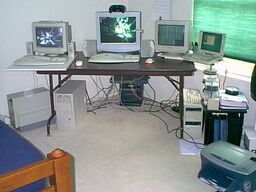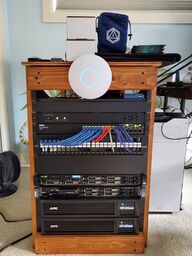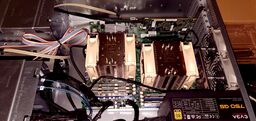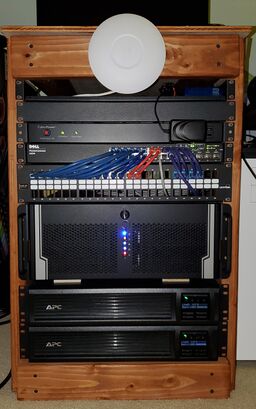Category:KYAULABS: Difference between revisions
(Created page with "{{DISPLAYTITLE:KYAU Labs}}<metadesc>KYAU Labs is a cutting-edge technological testing facility.</metadesc> <div style="padding: 0.25em 2em; background-color: rgba(19,19,19,0.8...") |
mNo edit summary |
||
| (5 intermediate revisions by the same user not shown) | |||
| Line 1: | Line 1: | ||
{{DISPLAYTITLE:KYAU Labs}}<metadesc>KYAU Labs is a cutting-edge technological testing facility.</metadesc> | {{DISPLAYTITLE:{{TitleIcon|kyaulabs=true}} KYAU Labs}}<metadesc>KYAU Labs is a cutting-edge technological testing facility.</metadesc> | ||
<div style=" | <div style="display:inline-block;font-family:'Agave';text-align:center">[[File:KYAULABS-BORDER.png|center|caption]]Think, Code, Test, Commit.</div> | ||
[ | {{margin}} | ||
Think, Code, Test, Commit.</div | |||
{{ | |||
{{Home|break=false}} | {{Home|break=false}} | ||
<div id="tocalign">__TOC__</div> | <div id="tocalign">__TOC__</div> | ||
= {{Icon24|sitemap}} Projects = | |||
* [//botpack.xyz/ botpack.xyz]: IRC botpack and tcl script archives, also contains helpful information for creating scripts. | |||
* [//voidbbs.com/ VOID BBS]: BBS running Worldgroup v3.30-NT, online off and on since 2004. | |||
= {{Icon24|sitemap}} Repositories = | |||
== {{Icon24|github}} GitHub == | |||
* [//github.com/kyau/win10tweak kyau/win10tweak]: Windows 10 installation automation | |||
* [//github.com/kyau/dotfiles kyau/dotfiles]: dotfiles from an Arch Linux power user | |||
== {{Icon24|gitlab}} GitLab == | |||
* [//gitlab.com/kyaulabs/aarch kyaulabs/aarch]: Arch Linux installation automation | |||
* [//gitlab.com/kyaulabs/aur kyaulabs/aur]: Arch Linux User Repository (KYAU Labs) | |||
* [//gitlab.com/kyaulabs/hybridcore kyaulabs/hybridcore]: security patch for eggdrop based on the eggdrop1.1.6 hybrid(core) patch | |||
* [//gitlab.com/kyaulabs/akira kyaulabs/akira]: a modern botpack ritten for hybrid(core) | |||
= {{Icon24|sitemap}} Tools = | |||
* [//tools.kyaulabs.com/color/ Colorrrs]: HEX <=> RGB converter | |||
= {{Icon24|sitemap}} KYAU Labs History = | = {{Icon24|sitemap}} KYAU Labs History = | ||
[[File:KYAULabs-20041021_101555.jpg|thumb|256px|right|KYAU Labs circa 2004]] | |||
I have been running a lab since... well since as long as I can remember. It is honestly hard to think of a time now when I haven't been running one, in some form or another. | |||
The "homelab" is merely a modern term for something that, upon reflection, has always been in my life. Everything that I know about computers and technology in general can be attributed to my lab. From learning how to code, to learning Linux & BSD, to dabbling in networking, none of this would have been possible without my lab. | |||
Whether my lab was running off of multiple regular PCs, off of a dedicated server and/or vps, or more recently on second-hand enterprise hardware. | |||
While some might already know that I have documented some of this over the years, originally in the form of whitepapers (back in my FreeBSD days) and more recently here on my [//kyau.net/wiki/ Wiki]. Back in 2018, with the purchase of a Dell R610, I started once more to rebuild my lab and wanted to document all of this. | |||
== {{Icon24|notebook}} Enterprise Hardware == | |||
[[File:KYAULabs-20190617_194624.jpg|thumb|x256px|right|KYAU Labs circa 2019, the enterprise era]] | |||
With the introduction of the [//www.amd.com/en/technologies/zen-core Zen 2 / Zen 3] architecture, while still a decent route to take, building a lab with second-hand enterprise hardware is becoming less and less cost-effective. Meaning that performance per dollar can be more easily attained by going the AMD route. | |||
Granted this depends heavily on the situation and how the hardware is obtained. If power is cheap in your area or if you work in an IT-related field and can get free or near-free hardware then it might not matter either way. | |||
== {{Icon24|notebook}} Server Upgrade == | |||
I recently ordered a bunch of parts to convert my R620 into a custom whitebox server. My rackmount cabinet sits next to my main pc and I honestly just can't handle the noise anymore. I previously had silenced all of the networking equipment in the rack (including the Dell PowerConnect 6224) by replacing all of the fans with aftermarket ones. | |||
==== NEUTRON is Born! ==== | |||
Once upon a colocation I had a server named NEUTRON, said server was the most powerful computer I had ever worked with at that point in my life. Given that it was such a huge beast I had named it NEUTRON after the neutron star, the most dense material known to man. Such a name I once again find fitting. | |||
==== NEUTRON Hardware ==== | |||
[[File:NEUTRON-20200224_192449.jpg|thumb|256px|right|NEUTRON, front view]] | |||
[[File:NEUTRON-20200228_032939.jpg|thumb|256px|right|NEUTRON, top view]] | |||
I have cobbled together all of the important parts out of the R620 and either purchased new or like-new used parts to fill in the gaps. The results of this build have been most impressive, with the dual CPUs idling at roughly ~23°C. That said, here is the final list of parts that went into the build. | |||
* 1 x [//www.ipc.in-win.com/rackmount-chassis-iw-r400-03n InWin R400-03N Open-Bay 4U Server Case] | |||
* 1 x [//www.supermicro.com/products/motherboard/Xeon/C600/X9DRi-F.cfm Supermicro X9DR3-F Motherboard] | |||
* 2 x [//ark.intel.com/content/www/us/en/ark/products/75269/intel-xeon-processor-e5-2650-v2-20m-cache-2-60-ghz.html Intel Xeon E5-2650 v2 (20M Cache, 2.6 GHz, 8.0 GT/s QPI)] | |||
* 6 x [//www.samsung.com/semiconductor/dram/module/M393B1K70CH0-YH9/ SAMSUNG 8GB PC3L-10600R (2Rx4, 1.35V, ECC Registered)] | |||
* 4 x [//www.samsung.com/semiconductor/dram/module/M393B5170FH0-CH9/ SAMSUNG 4GB PC3L-10600R (2Rx4, 1.5V, ECC Registered)] | |||
* 2 x [//noctua.at/en/nh-u9dx-i4 Noctua NH-U9DX i4 CPU Fan] | |||
* 2 x [//noctua.at/en/nf-r8-redux-1800-pwm Noctua NF-R8 redux Case Fan] | |||
* 1 x [//www.evga.com/products/product.aspx?pn=220-G5-0750-X1 EVGA SuperNOVA 750 G5] | |||
* 1 x [//www.broadcom.com/products/storage/host-bus-adapters/sas-9207-8i LSI 9207-8i SAS Host Bus Adapter] | |||
* 1 x [//www.icydock.com/goods.php?id=254 ICY DOCK ToughArmor MB607SP-B] + 1 x [//noctua.at/en/nf-a4x10-flx Noctua NF-A4x10 FLX] | |||
* 1 x [//www.samsung.com/us/support/owners/product/128gb-ssd-830-series Samsung SSD 830 Series 128GB] | |||
* 2 x [//www.westerndigital.com/support/hgst/internal-drives/mobile-laptop/ultrastar-c10k900 HGST Ultrastar C10K900 600GB 2.5" SAS2 10000RPM] | |||
* 2 x [//www.seagate.com/support/internal-hard-drives/laptop-hard-drives/barracuda-2-5/ Seagate Barracuda 5TB 2.5" SATA 6Gb/s] | |||
==== Conclusion ==== | |||
After getting the new machine put together I did some testing with ESXi, but once again settled on using Arch Linux + KVM for the host OS. Given the new hardware I wanted to do some extensive testing and some of that would have been a bit hard running just a hypervisor. | |||
[[File:KYAULabs-20200303_025822.jpg|thumb|256px|right|KYAU Labs circa 2020, current]] | |||
Finally here are some pictures of the new machine. | |||
And of course after getting the new server setup, I removed the R610 and R620 along with a 2U blank spacer from my rackmount cabinet and added in the new 4U. Hilariously enough, the loudest thing in my room now is the fan on my ODROID XU4. | |||
Latest revision as of 19:56, 23 November 2020
 Projects
Projects
- botpack.xyz: IRC botpack and tcl script archives, also contains helpful information for creating scripts.
- VOID BBS: BBS running Worldgroup v3.30-NT, online off and on since 2004.
 Repositories
Repositories
 GitHub
GitHub
- kyau/win10tweak: Windows 10 installation automation
- kyau/dotfiles: dotfiles from an Arch Linux power user
 GitLab
GitLab
- kyaulabs/aarch: Arch Linux installation automation
- kyaulabs/aur: Arch Linux User Repository (KYAU Labs)
- kyaulabs/hybridcore: security patch for eggdrop based on the eggdrop1.1.6 hybrid(core) patch
- kyaulabs/akira: a modern botpack ritten for hybrid(core)
 Tools
Tools
- Colorrrs: HEX <=> RGB converter
 KYAU Labs History
KYAU Labs History
I have been running a lab since... well since as long as I can remember. It is honestly hard to think of a time now when I haven't been running one, in some form or another.
The "homelab" is merely a modern term for something that, upon reflection, has always been in my life. Everything that I know about computers and technology in general can be attributed to my lab. From learning how to code, to learning Linux & BSD, to dabbling in networking, none of this would have been possible without my lab.
Whether my lab was running off of multiple regular PCs, off of a dedicated server and/or vps, or more recently on second-hand enterprise hardware.
While some might already know that I have documented some of this over the years, originally in the form of whitepapers (back in my FreeBSD days) and more recently here on my Wiki. Back in 2018, with the purchase of a Dell R610, I started once more to rebuild my lab and wanted to document all of this.
 Enterprise Hardware
Enterprise Hardware
With the introduction of the Zen 2 / Zen 3 architecture, while still a decent route to take, building a lab with second-hand enterprise hardware is becoming less and less cost-effective. Meaning that performance per dollar can be more easily attained by going the AMD route.
Granted this depends heavily on the situation and how the hardware is obtained. If power is cheap in your area or if you work in an IT-related field and can get free or near-free hardware then it might not matter either way.
 Server Upgrade
Server Upgrade
I recently ordered a bunch of parts to convert my R620 into a custom whitebox server. My rackmount cabinet sits next to my main pc and I honestly just can't handle the noise anymore. I previously had silenced all of the networking equipment in the rack (including the Dell PowerConnect 6224) by replacing all of the fans with aftermarket ones.
NEUTRON is Born!
Once upon a colocation I had a server named NEUTRON, said server was the most powerful computer I had ever worked with at that point in my life. Given that it was such a huge beast I had named it NEUTRON after the neutron star, the most dense material known to man. Such a name I once again find fitting.
NEUTRON Hardware
I have cobbled together all of the important parts out of the R620 and either purchased new or like-new used parts to fill in the gaps. The results of this build have been most impressive, with the dual CPUs idling at roughly ~23°C. That said, here is the final list of parts that went into the build.
- 1 x InWin R400-03N Open-Bay 4U Server Case
- 1 x Supermicro X9DR3-F Motherboard
- 2 x Intel Xeon E5-2650 v2 (20M Cache, 2.6 GHz, 8.0 GT/s QPI)
- 6 x SAMSUNG 8GB PC3L-10600R (2Rx4, 1.35V, ECC Registered)
- 4 x SAMSUNG 4GB PC3L-10600R (2Rx4, 1.5V, ECC Registered)
- 2 x Noctua NH-U9DX i4 CPU Fan
- 2 x Noctua NF-R8 redux Case Fan
- 1 x EVGA SuperNOVA 750 G5
- 1 x LSI 9207-8i SAS Host Bus Adapter
- 1 x ICY DOCK ToughArmor MB607SP-B + 1 x Noctua NF-A4x10 FLX
- 1 x Samsung SSD 830 Series 128GB
- 2 x HGST Ultrastar C10K900 600GB 2.5" SAS2 10000RPM
- 2 x Seagate Barracuda 5TB 2.5" SATA 6Gb/s
Conclusion
After getting the new machine put together I did some testing with ESXi, but once again settled on using Arch Linux + KVM for the host OS. Given the new hardware I wanted to do some extensive testing and some of that would have been a bit hard running just a hypervisor.
Finally here are some pictures of the new machine.
And of course after getting the new server setup, I removed the R610 and R620 along with a 2U blank spacer from my rackmount cabinet and added in the new 4U. Hilariously enough, the loudest thing in my room now is the fan on my ODROID XU4.
Pages in category "KYAULABS"
The following 2 pages are in this category, out of 2 total.





